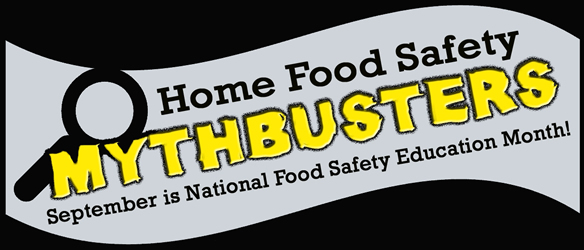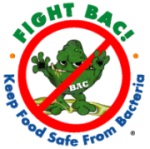Home Food Safety

Home Food Safety Mythbusters
Over the years we have all heard advice related to food safety. Some of this advice rings true, while other guidance is just plain wrong. To help you protect yourself and your family from foodborne illness, the Partnership for Food Safety Education has created new materials for consumers and educators that debunk common home food safety myths. Brush up on safe food handling advice with Fight BAC!
Myth 1: Only kids eat raw cookie dough and cake batter. If we just keep kids away from the raw products when adults are baking, there won’t be a problem!
FACT: Just a lick can make you sick! No one of any age should eat raw cookie dough or cake batter because it could contain germs that cause illness. Whether it’s prepackaged or homemade, the heat from baking is required to kill germs that might be in the raw ingredients. The finished, baked, product is far safer – and tastes even better! And remember, kids who eat raw cookie dough and cake batter are at greater risk of getting food poisoning than most adults are.
Myth 2: When kids cook it is usually “heat and eat” snacks and foods in the microwave. They don’t have to worry about food safety – the microwaves kill the germs!
FACT: Microwaves aren’t magic! It’s the heat the microwaves generate that kills the germs! Food cooked in a microwave needs to be heated to a safe internal temperature. Microwaves often heat food unevenly, leaving cold spots in food where germs can survive. Kids can use microwaves properly by carefully following package instructions. Even simple “heat and eat” snacks come with instructions that need to be followed to ensure a safe product. Use a food thermometer if the instructions tell you to!
Myth 3: When kids wash their hands, just putting their hands under running water is enough to get the germs off.
FACT: Rubbing hands with water and soap is the best way to go! Water is just part of what you need for clean hands! Washing hands properly is a great way to reduce the risk of food poisoning. Here’s how: Wet your hands with clean, running water and apply soap. Rub them together to make a lather and scrub them well; be sure to scrub the backs of hands, between fingers, and under nails. Continue rubbing for at least 20 seconds. Sing the “Happy Birthday” song twice to time yourself! Rinse hands well under running water. Dry your hands using a clean towel, paper towel, or an air dryer.
Myth 4:My kids only eat pre-packaged fruits and veggies for snacks because those snacks don’t need to be washed before they eat them.
FACT: Read your way to food safety! Giving your kids healthy snacks is a big plus for them! But just because produce is wrapped, it doesn’t always mean it’s ready to eat as is. Read the label of your product to make sure it is says: “ready-to-eat,” “washed,” or “triple washed.” If it does, you’re good to go! If it doesn’t, wash your hands and then rinse the fruits or vegetables under running tap water. Scrub firm items, such as melons and cucumbers, with a clean produce brush. Dry with a clean cloth towel or paper towel to further reduce germs that may be present.

Use these helpful links to increase your knowledge of the issues regarding Nutrition and Health:
Virginia Cooperative Extension Publications–Health & Nutrition, Food Safety, Food Preservation, and Community Food Systems
Publications on a variety of issues including: Biotechnology, Cancer Prevention, Canning & Preserving, Childhood Nutrition, Cooking & Meal Planning, Food Guide Pyramid, Food Safety, Food Science, Health & Exercise, Heart Disease, High Blood Pressure (Hypertension), Home Pests, Home Safety, Kitchens, Nutrition for Senior Adults, Shopping, Water Quality, and Weight Management.
The Food Safety and Inspection Service (FSIS)
Protecting Public Health Through Food Safety and Security. The Food Safety and Inspection Service (FSIS) is the public health agency in the U.S. Department of Agriculture responsible for ensuring that the nation’s commercial supply of meat, poultry, and egg products is safe, wholesome, and correctly labeled and packaged.
The National Center for Home Food Preservation
The National Center for Home Food Preservation is your source for current research-based recommendations for most methods of home food preservation. The Center was established with funding from the Cooperative State Research, Education and Extension Service, U.S. Department of Agriculture (CSREES-USDA) to address food safety concerns for those who practice and teach home food preservation and processing methods.


